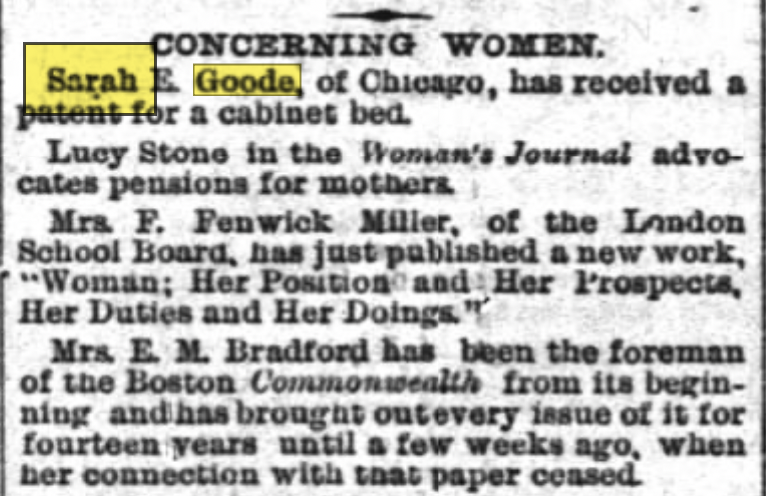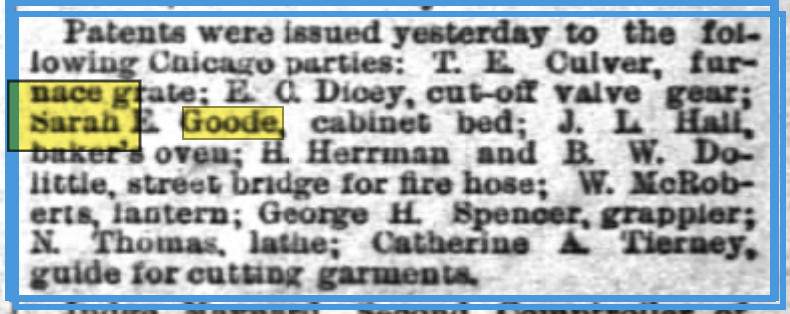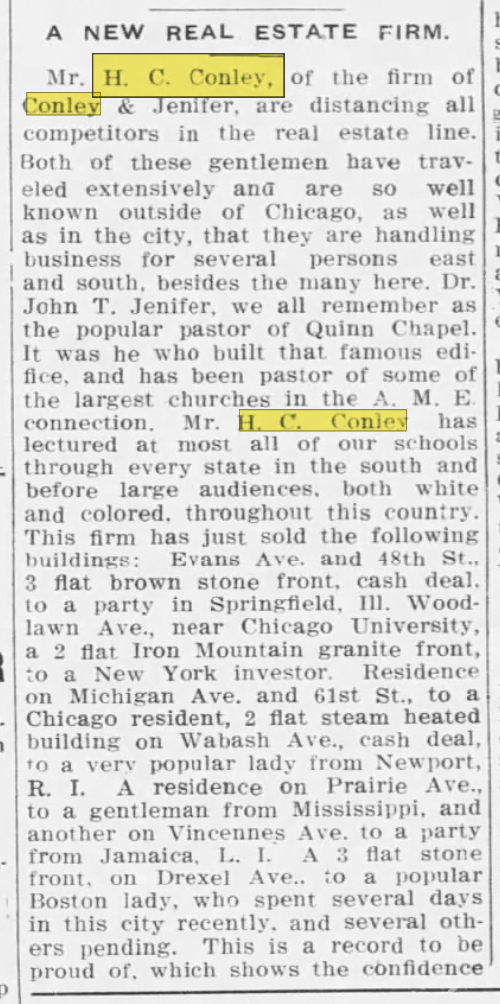H.C. Conley - ENTREPRENEUR, Pioneering Filmmaker, REAL ESTATE INVESTOR
H.C. Conley was an enterprising intellectual in the mold of Conleys before and after him. He began as an academic, and became popular professor, lecturing in history and the humanities at AME Methodist colleges across the country. He prospered as a builder of chicken coops called Kenilworth Poultry Yards, then as a filmmaker, and finally as a real estate broker.
Harry C. Conley and Hattie Goode were married 4th of June in 1902 in Lake, Indiana.
KENILWORTH POULTRY YARDS
Initially, Harry Conley used his carpentry skills to create Kenilworth Poultry Yards, a builder of chicken coops. The business performed very well, exploiting the increased demand for food as the population of Chicago grew rapidly after the Civil War.
1895-1900 : THE FILM BUSINESS
THE ORIGINS OF CONLEY’S MOVING PICTURE SHOW
It was 1893, and Thomas Edison had just opened Edison Studios. The first films for public exhibition in 1893–95, most were short form skits about everyday life.
Not long after Edison Studios opened, in 1897, amateur historians H.C. Conley and his wife Hattie Alice Goode Conley, were the founders of groundbreaking movie production studio called, “Conley’s Great Moving Picture Show.” As was typical in 1897 ‘movie’ productions combined a few minutes of silent film footage at a time, with live music, and spoken word descriptions.
Harry C. Conley, professionally known as ‘H.C. Conley”
1876-1911
Hattie Jacobs Goode Conley, known as ‘Alice’ to friends.
1881-1910.
TURN OF THE CENTURY FILMS ABOUT THE TALENTED TENTH
Ever the entrepreneur, H.C. could see the promise in using Edison’s technology to tell richer, more colorful stories about pivotal historical figures who comprised the “Talented Tenth”, a cadre of elite intellectuals of Black American descent. These people of color were alternatively called “Aristocrats of Color” by White Southerners. Newspaper articles of these figures captured the imagination, but their numbers were small, and the bigger picture was often lost. Worse, practically no one wanted to read the long form biography books about these extraordinary people.
With this in mind, H.C. and his wife Alice set out to create early versions of today’s biographical movies or ‘BioPics’ - films, with orchestras, and on-stage commentary. This format (short silent film with on-stage narration and music) became the standard for telling the stories of historical figures, well-known persons, or groups of people before World War One.
1900 to 1910: Traveling the worlD:
H.C. Conley travelled throughout North & South America, exhibiting early forms of documentaries about the Aristocrats of Color. His films centered on the stories, exploits, and adventurers of America’s overachieving group of Black intellectuals at the apex of their power. Figures like Richard Theodore Greener, James Weldon Johnson, and William Henry Hunt were in their finest hour in the era between 1900 and thew outbreak of World War 1 in 1914, and H.C. Conley was the only filmmaker telling their stories in the earliest days of the new technology. Newspapers, periodicals, society pages catering to the Black Elite advertised H.C. Conley’s films, plays and lecturers as he toured North and South America.
Advertisement from the June 24th issue of the Washington Bee, once the America’s best known newspaper catering to the educated Black Elite at the turn of the 20th century. This one of Conley’s short films featured the story Frederick Douglass, and the rivalry of W.E.B DuBois, and Booker T. Washington, set to music from Frédéric Chopin the composer and virtuoso pianist of the Romantic period. In a display of cultural sophistication the short clips were accompanied by songs from Italian operatic stars Enrico Caruso and Adelina Patti, as well as Australian legend Dame Nellie Melba.
1907 Advertisement for a Conley show .
IT’s A FAMILY AFFAIR
Harry ‘H.C.’ Conley, and his wife Hattie Alice Conley financed their films and traveling exhibition with his significant earnings from building chicken coops and his real estate investments. But, Alice’s parents also invested heavily.
H.C. Alice, and her parents Archibald & Sarah Goode, made for an enterprising quartet. They financed all their owns films, and the hiring of musicians and speakers. Alice was the business brains of the operation, and is currently subject of research at the WOMEN FILM PIONEERS PROJECT at Columbia University of New York.
ARCHIBALD & SARAH GOODE. Harry‘s in-laws were very successful business people. Archibald was a furniture maker, and with his wife, opened a retail furniture storefront catering to the millions of newcomers arriving in Chicago at the end of Civil War. However, Archibald’s wife Sarah E. Goode was the engine behind the couple’s success. Sarah’s mechanical engineering talent combined with her business savvy brought family great prosperity.
The Conleys’ mixed media productions (and Sarah’s furniture) were shown at meetings wherever Black American academic, business, and arts figures gathered. The National Business League, Nation's First Black Business Organization is a prime example.
Sarah E. Goode was the first African-American woman to be granted a patent by the U.S. Patent and Trademark Office, for her invention of a folding cabinet bed in 1885.
There is no extant photo of Sarah E. Goode.
Dozens of related websites include photographs of women of color purported to be Sarah E. Goode. The two most commonly used photos are of women whose features do not match Sarah E. Goode’s at all. Through extant images of her daughter, and the fact that Sarah ‘passed’ as an immigrant from Spain, we know that photographs of much younger sculpture artist Mary Edmonia Lewis, and a much older English-born Sarah Goode Marshall Chadwick, cannot possibly be Sarah E. Goode. Even a source as trustworthy A&E Network’s Biography site used photos of Edmonia Lewis and Sarah Goode Marshall in error. As of May 2013 the A&E website has removed these photos.
MORE ON SARAH GOODE, MOTHER-IN-LAW AND MENTOR TO H.C. CONLEY
SARAH E. GOODE was born to a free black/mullatto family in Toledo, Ohio. Sarah was an inventor and entrepreneur She died in 1905.
After receiving her freedom at the end of the Civil War, Goode moved to Chicago and eventually became an entrepreneur. Along with her husband Archibald, a carpenter, she owned a furniture store. Many of her customers, who were mostly working-class, lived in small apartments and didn't have much space for furniture, including beds.
As a solution to the problem, Goode invented a cabinet bed, which she described as a "folding bed," similar to what nowadays would be called a Murphy bed. When the bed was not being used, it could also serve as a roll-top desk, complete with compartments for stationery and other writing supplies.
They produced and exhibited their own motion pictures, often transforming black churches into motion picture theaters during off hours. These film exhibitions raised money for black institutions, created shared social experiences, and broadcast ideas about racial uplift.” - The University of Indiana.
Historian Cara Caddoo, PhD
Historian Cara Caddoo chronicled the work of H.C. Conley and his wife Alice in her book ENVISIONING FREEDOM. Her tireless research shed new light on Conley’s contributions in light of the broader history of cinema. From Professor Caddoo’s website at the University of Indiana, “In the late nineteenth century, an era marked by mass migration and Jim Crow segregation, African Americans were pioneers of American cinema. “
Author and historian of Black American Film, Professor Cara Caddoo. “As African Americans integrated the moving pictures into their aspirations for black progress, a vibrant black cinema culture developed across the pathways of turn-of-the-century migration.” - The University of Indiana.
HISTORICAL NOTE:
They Dr. Cara Caddoo, discovered the oldest surviving footage from a Black film company in American history. The film, "The Trooper of Troop K," was produced on October 16, 1916 by the Lincoln Motion Picture company. The Library of Congress points out that many silent films have been lost and that materials shot by Black filmmakers before 1920 are even harder to come by. While Oscar Micheaux deserves his place in American history, he is incorrectly cited on hundreds of websites as the first Black American filmmaker. This is incorrect. He was primarily a novelist, and his first film, an adaptation of one of his novel was not released until 1919, a decade after H.C. Conley’s early films using Edison equipment.
1910 : REAL ESTATE
After the unexpected death of his wife in 1910, H.C. Conley poured himself into his real estate business.
MARCH 3, 1910. Real Estate






















